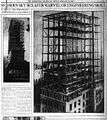Andrew Young School of Policy Studies
| Type | Public |
|---|---|
| Dean | Mary Beth Walker |
| Students | 4,500 enrolled |
| Location | Atlanta, Georgia, USA |
| Campus | Urban |
| Website |
www |
The Andrew Young School of Policy Studies is located within Georgia State University. The school houses the Criminal Justice & Criminology, Economics, Social Work and Public Management and Policy divisions of the second largest school in the state of Georgia.
In 2008, U.S. News and World Reports placed the Andrew Young School 27th among the top 269 schools in public affairs: 5th in public finance and budgeting, 12th in city management/urban policy, 12th in information and technology management, 13th in nonprofit management, 18th in public policy analysis, and 33rd in public management administration.
The school is named after Andrew Young, a civil rights leader from Atlanta that served as mayor of Atlanta, United Nations Ambassador, and was instrumental in bringing the Olympics to the city in 1996.
History
The Georgia State University Policy School was founded in July, 1996 as an expansion of the small policy research center that had been growing since its establishment in 1988. In 1999, The Policy School was renamed the Andrew Young School of Policy Studies to honor former Ambassador and Atlanta Mayor Young's contributions to the city of Atlanta.
Departments
- The Department of Criminal Justice & Criminology[1]
- The Department of Economics[2]
- The Department of Public Management and Policy[3]
- The School of Social Work[4]
Research Centers and Programs
Domestic Programs
- Center for Collaborative Social Work
- Center for State and Local Finance
- Domestic Programs
- Experimental Economics Center (ExCEN)
- Fiscal Research Center
- Georgia Health Policy Center
- GILEE (Georgia International Law Enforcement Exchange)
- International Studies Program
- Nonprofit Studies Program
- Public Performance Management Group
Degree Programs
The Andrew Young School offers various undergraduate programs, a master's program, and a doctoral degree track.
Undergraduate Degree Programs
- Bachelor of Arts (B.A.) in Economics
- Bachelor of Science (B.S.) in Economics
- Bachelor of Science (B.S.) in Criminal Justice
- Bachelor of Arts (B.A.) in International Economics & Modern Languages
- Bachelor of Science (B.S.) in Public Policy
- Bachelor of Arts (B.A.) in Social Work
Graduate Degree Programs
- Master of Arts in Economics
- Master of Arts in Economics - Public Policy Track
- Master of Public Administration (M.P.A.)
- Master of Public Administration (M.P.A.) / Juris Doctor (J.D.)
- Master of Public Policy (M.P.P.) in Policy Studies
- Master of Social Work (M.S.W.) in Social Work
- Master of Science (M.S.) in Criminal Justice
- Peace Corps Masters International Program
Doctoral Degree Programs
- Doctor of Philosophy (Ph.D.) in Criminal Justice and Criminology
- Doctor of Philosophy (Ph.D.) in Economics
- Doctor of Philosophy (Ph.D.) in Public Policy with the Georgia Institute of Technology
- Doctor of Philosophy (Ph.D.) in Public Policy
Graduate Certificate programs include:
- Disaster Management
- Nonprofit Management
- Planning and Economic Development
The Faculty
The Andrew Young School boasts some of the top faculty from their respective disciplines.
The Facility
-

1904 Atlanta Constitution article about the building's construction
-

1905 newspaper ad celebrating the grand opening of the bank's new headquarters building
-
Interior of Fourth National Bank building, c.1906
-
Fourth National Bank building, about 1908
-

1915 advertisement for the Fourth National Bank and tenants in its headquarters building
The current home of the Andrew Young School of Policy Studies has a varied past, as the building dates to 1905. The Fourth National Bank opened the building on the southwest corner of Marietta and Peachtree streets in 1905 - the site of the Norcross Building which had burned in a 1902 fire – and was for one year the tallest building in the city until the Candler Building was built. Morgan & Dillon designed the building.
In 1928 firm Pringle & Smith directed addition of several floors to the building, an extension northward along Marietta street resulting in an L-shaped building, and a renovation of the interior to an even more opulent style.[5]
In 1966, First National Bank built a 41-story tower on the lot adjacent to the south, site of the Peachtree Arcade (1917-1964); today the State of Georgia Building; the architect was Cecil Alexander. It removed the top half of the original building and resurfaced it in the white marble that covers it today.
References
- ↑ "Archived copy". Archived from the original on 2011-10-15. Retrieved 2011-11-16.
- ↑ "Archived copy". Archived from the original on 2010-08-14. Retrieved 2010-08-09.
- ↑ "Archived copy". Archived from the original on 2011-11-30. Retrieved 2011-11-16.
- ↑ "Archived copy". Archived from the original on 2011-11-14. Retrieved 2011-11-16.
- ↑ The Architecture of Francis Palmer Smith, Atlanta's Scholar-Architect, Robert M. Craig, p.136. Books.google.com. Retrieved 2013-12-08.
External links
Coordinates: 33°45′15″N 84°23′24″W / 33.7543°N 84.3901°W